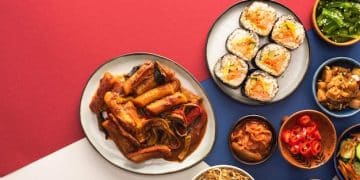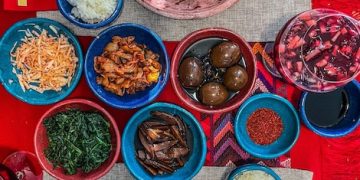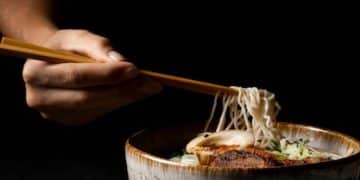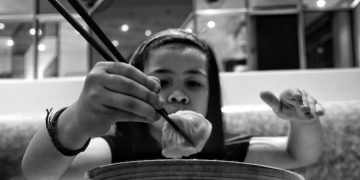Korean Drama Food Culture: Delicious Dishes & Culinary Delights
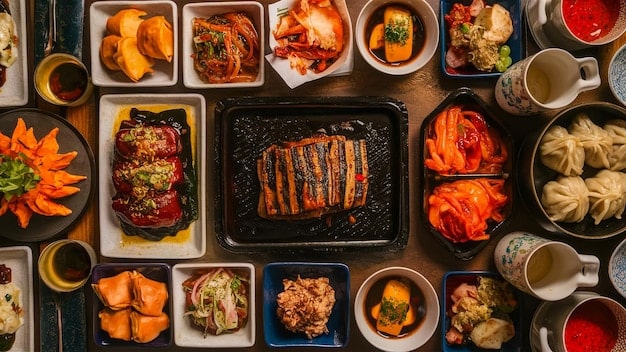
Advertisements
Korean drama food culture offers a fascinating glimpse into Korean cuisine through the delicious dishes featured in popular shows, showcasing traditional flavors like kimchi and bulgogi, as well as modern favorites.
The world of Korean dramas, or K-dramas, is not just about compelling storylines and captivating characters; it’s also a vibrant portal into Korean culture, particularly its food. Exploring Korean drama food culture provides a unique lens through which to appreciate the culinary delights that are integral to Korean life.
Anúncios
Korean Drama Food Culture: A Delicious Introduction
Korean dramas have taken the world by storm, and with good reason. Beyond the compelling narratives and charismatic actors, these shows offer a tantalizing glimpse into Korean culture. Food plays a starring role, providing not just sustenance but also a visual and emotional feast. From the communal sharing of bibimbap to the comforting warmth of kimchi jjigae, Korean drama food culture is deeply embedded in the storylines.
This article will dive into the delicious world of food as portrayed in your favorite K-dramas, exploring the cultural significance, iconic dishes, and mouth-watering moments that make these shows so captivating.
Anúncios
The Cultural Significance of Food in K-Dramas
In Korean culture, food is more than just sustenance; it’s a symbol of connection, respect, and love. K-dramas beautifully illustrate this, often depicting food as a central element in social interactions and family dynamics.
Here’s how food plays a significant role:
Family Meals and Bonding
Family meals are a cornerstone of Korean life, and K-dramas frequently showcase these gatherings. Scenes around the dinner table are not just about eating; they’re about sharing experiences, resolving conflicts, and strengthening familial bonds.
Respect for Elders
The act of serving food to elders is a sign of respect in Korean culture, and K-dramas often depict younger characters meticulously preparing and presenting meals to their seniors. This highlights the importance of filial piety and the hierarchical structure within Korean families.
Comfort and Healing
Food is often used as a means of comfort and healing in K-dramas. Characters going through tough times might be offered a bowl of warm rice or a comforting stew, symbolizing care and support during difficult moments. This demonstrates the nurturing aspect of food within relationships.
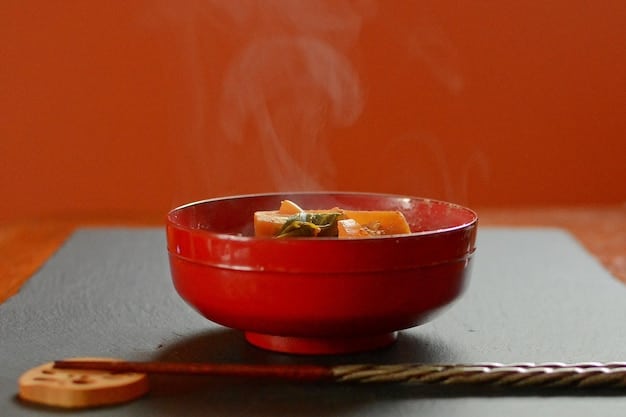
Food as a Romantic Gesture
Preparing a meal for someone is a classic romantic gesture, and K-dramas are full of examples. From packed lunches filled with carefully made Korean dishes to elaborate home-cooked dinners, food is often used to express love and affection between characters.
In many Korean dramas, food serves as more than just mere plot device; it is a character in itself, actively enhancing the story’s emotional depth and cultural richness. It’s a powerful medium that adds layers of meaning to scenes.
Food is not just fuel; it’s a language of love, respect, and connection in K-dramas, reflecting its profound cultural significance in Korean society.
Iconic Korean Dishes Frequently Featured in K-Dramas
Korean dramas often feature a variety of iconic dishes that provide viewers with a glimpse into the country’s rich culinary heritage. These dishes are not only visually appealing but also integral to the narrative, reflecting the cultural context and emotional states of the characters.
Here are some of the most frequently featured dishes:
- Kimchi (김치): This fermented cabbage dish is a staple of Korean cuisine and appears in almost every K-drama. It symbolizes Korean identity and is a constant presence at mealtimes.
- Bibimbap (비빔밥): A colorful mixed rice dish with vegetables, meat, and a fried egg, bibimbap represents harmony and balance. It’s often enjoyed as a communal meal, signifying togetherness.
- Tteokbokki (떡볶이): These spicy rice cakes are a popular street food and a common sight in K-dramas. They symbolize comfort and are often enjoyed during casual gatherings or as a late-night snack.
- Bulgogi (불고기): Marinated grilled beef, known for its sweet and savory flavors, bulgogi is a celebratory dish often served during special occasions. It represents abundance and prosperity.
Exploring these dishes provides a deeper understanding of Korean culinary traditions. Each ingredient and the way they are prepared hold special significance, contributing to the food’s narrative within the drama.
These iconic dishes are not just part of the scenery but also actors in the story, carrying cultural weight and emotional resonance.
These are just a few examples, a way to showcase the amazing world that Korean foods offer. These foods are an integral part of understanding the Korean culture and the message its dramas are conveying.
Must-Try Street Foods in K-Dramas: A Culinary Adventure
Korean street food plays a significant role in K-dramas, offering viewers a tantalizing glimpse into the vibrant and accessible culinary landscape of Korea.
Here are some must-try street foods:
Tteokbokki (떡볶이)
As previously mentioned, tteokbokki’s spicy rice cakes are a national obsession. They are typically available in numerous variations that cater to different taste buds, like the cheese tteokbokki and seafood tteokbokki.
Hotteok (호떡)
Hotteok’s sweet pancakes are usually filled with brown sugar, cinnamon, as well as many different nuts. They’re hot, chewy, and provide amazing comfort, especially during winter nights. The pancakes are often featured in K-dramas during scenes that need such comfort.
Bungeoppang (붕어빵)
Bungeoppang is a fish-shaped pastry that is a big hit for all ages. Generally filled with sweet red bean paste, it is commonly seen in dramas, with characters enjoying them as a sweet treat while walking down the streets.
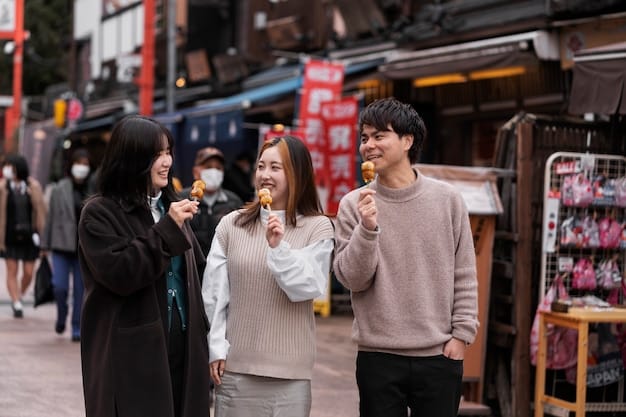
Korean Fried Chicken (치킨)
Korean fried chicken is renowned for its exceptional crunch and an array of flavors ranging from spicy to sweet and savory. Its immense popularity makes it a staple meal in K-dramas, often featured during gatherings among people.
Street food is not just about taste; it’s an experience. This experience is also translated into the dramas, giving the stories a sense of being real.
Sampling these street foods allows a taste of the genuine Korean experience that is often depicted in the shows.
Exploring Korea’s street food scene through K-dramas offers an authentic taste of Korean culture. What is being sold along the streets are not just meals, they are cultural experience as well.
Cooking Scenes That Steal the Show
Cooking scenes in K-dramas not only highlight the process of preparing food but also provide insight into the characters’ personalities and relationships.
These cooking scenes usually involve:
Detailed Food Preparation
K-dramas often showcase intricate food preparation methods, highlighting the care and attention that goes into creating traditional Korean dishes. This also includes carefully selecting fresh ingredients to the intricate steps involved in fermentation as well as seasoning.
Character Development
Cooking scenes serve to reveal aspects of the characters’ personalities. A meticulous home cook might be portrayed as detail-oriented and nurturing, while someone who struggles in the kitchen might be shown as endearing.
Culinary Battles
Some K-dramas revolve around cooking competitions. These scenes showcase incredible techniques of innovative cuisine as the characters compete to be on top. It’s exciting to watch the competition and savor the visual allure of each dish, and learn new methods.
These are all great examples, but they don’t stop there, as these scenes are a narrative that goes beyond providing information.
Such moments add depth to the narrative, showcasing the passion and tradition behind Korean food culture.
The portrayal of food preparation is not just instructional; it enriches the narrative and emphasizes the emotional depth of interpersonal relationships.
Notable K-Dramas That Showcase Korean Food Culture
Several popular K-dramas have gained recognition for their captivating portrayals of Korean food culture, weaving culinary elements directly into their storylines.
Viewers should watch these well-known dramas:
- “Let’s Eat” (식샤를 합시다): Famous by the viewers, this drama highlights the food. The drama follows a man, Goo Dae-young, who loves to explore and enjoy various food. Each episode really showcases the various types of dishes and a demonstration on how delicious the Korean cuisine is.
- “Pasta” (파스타): Set up in a kitchen, “Pasta” will take the viewers to the Italian cuisine world. This also translates how food affects interpersonal relationships, and the passion for creating good food for the people.
- “Dae Jang Geum” (대장금) / “Jewel in the Palace”: Viewers will go back in time as this historical drama is about a female cook working for the royal family. Not only will it tell the hardships and determination of the character, but it will show the intricacies of how the royal family prepares food.
- “Wok of Love” (기름진 멜로): Set in the culinary background, this drama is about a chef who is trying to revitalize a Chinese restaurant and create authentic dishes. The viewers are taken over to the kitchen side of preparing the food.
These dramas have great visuals to show, but what sets them apart is the emphasis on character development and plot enhancement through Korean traditional meals.
These shows use food as a cultural narrative. It tells a message that food is not just a dish, but a story.
Viewers get hooked not only by the intricate plot lines displayed in the dramas, but mostly the cultural significance of the dishes that make them crave for more.
How K-Dramas Influence Food Trends and Tourism
Korean dramas have a significant impact on global food trends and tourism, which has also translated into the food industry.
Here’s how K-dramas are impacting the food industry.
Increased Interest in Korean Cuisine
These are the trends:
As K-dramas gain popularity, viewers often become curious about featured dishes, leading to an increased interest in Korean cuisine. It is interesting how the food has become an ambassador of promoting Korean culture. These have led to more interest in general.
Popularity of Korean Restaurants
The portrayal of Korean dishes in popular shows drives diners from around the world to seek out ethnic restaurants to try them out. These will result in more opportunities that showcase the dishes and the Korean culture.
Culinary Tourism
Fans eager to experience the food culture firsthand increasingly visit South Korea. Many tourists are influenced to visit by the food featured, and create new experiences to enjoy the Korean dramas as their guide.
The dishes are not only a visual appeal, but it evokes curiosity and hunger for new experiences.
This influence highlights the K-dramas’ power beyond entertainment, where they play a pivotal role in shaping culinary interests and promoting cultural tourism.
Korean dramas have managed not just to entertain, but to open new doors for promoting the culture of Korean dishes to the diverse viewers.
| Key Highlights | Brief Description |
|---|---|
| 🍜 Iconic Dishes | K-dramas highlight kimchi, bibimbap, tteokbokki, and bulgogi. |
| 🍢 Street Food | Must-try’s featured include tteokbokki, hotteok, bungeoppang and etc. |
| 🎬 Dramas to Watch | Watch “Let’s Eat”, “Pasta”, “Dae Jang Geum”, and “Wok of Love”. |
| 📈 Trends & Tourism | Culinary Tourism of travelers wanting to explore Korean cuisine. |
Frequently Asked Questions
▼
Korean food is appealing in K-dramas as it showcases the cuisine, evokes familiar feelings of comfort and warmth, and connects stories that are also relatable to everyone.
▼
K-dramas stimulate viewers’ curiosity, which in turn is driving them to visit Korean dining establishments. Some also try to emulate the dishes that they see in their screens at home.
▼
In Korean social gatherings, the role of the food depicts harmony as families and friends get together and share a meal, share stories, and make strong bonds to ensure a healthy relationship.
▼
Some must-watch K-dramas for their food scenes: “Let’s Eat”, known for showcasing a variety of Korean dishes, “Pasta” shows the intense kitchen setting, and “Dae Jang Geum” that highlights royal food history.
▼
Korean food culture has changed over time with the innovation of different chefs, and influence of global trends. However, the food still stayed as a connection for families and friends to nurture bonds.
Conclusion
Exploring Korean drama food culture provides not only a window into Korean cuisine but also insight into the cultural values and societal dynamics that shape Korean life. From the comforting familiarity of kimchi to the communal joy of bibimbap, food serves as a powerful narrative tool in K-dramas, reflecting love, respect, and connection. As these dramas continue to captivate audiences worldwide, their influence on food trends and culinary tourism is undeniable, making Korean drama food culture a compelling subject to explore and appreciate.

